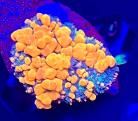Acclimation
CORAL, FISH AND INVERTEBRATE ACCLIMATION GUIDE
Please read carefully; Very important!!!!!
You have spent time and money on this precious and delicate coral and/or invertebrate; let’s provide it with an opportunity to live a long and healthy life in its new home. There are a number of important water parameters and tank conditions that you need to slowly adjust your new coral and/or invertebrate to. The major parameters are:
® Temperature
® Salinity
® pH
® Lighting intensity; not so important for snails, crabs, and shrimp
ACCLIMATION STEPS FOR CORAL
1) The temperature in the shipping bag will be different than the temperature of your aquarium. Remove all outer shipping bags, leaving the last bag housing your coral sealed. Please float in the sealed bag all new specimens for at least 15-20 minutes.
2) Open bag and roll top edge of bag just enough to create an air pocket under the lip of the bag. The bag will float and not sink in the tank. Slowly add a small amount of tank water. Repeat every 4-5 minutes until bag is full. Lift bag out of tank and discard approximately half of the water. Return to tank and add more of tank water, keep adding until bag is full. Never add the shipping water into your aquarium.
3) Recommended: Now for the coral dip. Every coral arriving at our facility is dipped to remove any pathogens so as not to infect my system. We suggest you should do the same as a precaution against transferring possible pathogens into your system and to ensure coral health. Only use iodine on SPS and LPS. Do not use on anemones or clams. Please read the manufacturers instructions on the coral dip bottle for the proper dipping technique. Always remember to give coral a good rinse with tank water before putting in your system.
4) Now is the time to relocate the coral to its new home. Please grab the coral by the base/hard exoskeleton/plug/or disk/ using an aqua glove or similar glove if possible. Avoid touching the polyps or flesh of the coral. The coral may have an excess coating of slime from the shipment; a gentle shaking of the coral while still in the tank water rinse will help remove most of the slime before placing in tank.
5) Highly recommended to place coral on sand bed at this time. No matter what lighting situations too much light can cause coral to “sunburn”, or bleach quickly. Placing the new specimen toward the bottom of the tank under mild current for up to a week and monitoring its condition will help insure a healthy coral. Make sure the coloration and expansion of coral are perceived as good. After this timeline the coral can be placed in its final location in your aquarium. Even then monitor its response and “health.” You might need to find another home better suited to its demands. Observe the coral and all fish, make sure you do not have a tank inhabitant that does not like where your new coral is and picks on it. Also make sure your new coral has room to grow and will not be in a territory battle with another specimen.
ACCLIMATION GUIDE FOR FISH
Please read carefully; Very important!!!!!
You have spent time and money on this precious and delicate fish; let’s provide it with an opportunity to live a long and healthy life in its new home. There are a number of important water parameters and tank conditions that you need to slowly adjust your new tank mate to. Proper acclimation is important to ensuring successful introduction and continued health of your new fish. The major parameters are:
® Temperature
® Salinity
® pH
1) Turn off aquarium lights. Also dim the lights where you will be unboxing your new fish. It will keep the stress level down on your new purchase.
2) The temperature in the shipping bag will be different than the temperature of your aquarium.Remove all outer shipping bags, leaving the last bag housing your fish sealed.Please float in thesealed bag all new specimens for at least 15 minutes. Open bag and roll top edge of bag just enough to create an air pocket under the lip of the bag. The bag will float and not sink in the tank. Slowly add a small amount of tank water. Repeat every 4-5 minutes until bag is full. Lift bag out of tank and discard approximately half of the water. Return to tank and add more of tank water, keep adding until bag is full. Never add the shipping water into your aquarium.
Now net the fish in the bag and release into the aquarium. Take shipping bag full of water and discard.
®the whole process should not take more than an hour. Never rush the acclimation procedure.
®never place an air stone in the bag. This will increase the pH in the shipping bag and causelethal ammonia levels.
®Keep your aquarium lights off for at least 4-5 hours
®Some fish may appear dead or dying; still continue with the acclimation steps. Some may appear dead or severely stressed but will revive after the acclimation procedure.
Note: These procedures are a suggestion for the acclimation of your new fish. They have been highly successful for us, and we want to pass it on. It seems everyone has their own ideas, techniques, and methods. We want you to be totally satisfied with your purchase from Spikes Corals for years to come.
If you have a loss of fish: Please see our guarantee guidelines
INVERTEBRATE ACCLIMATION GUIDE
Crabs, snails, shrimp are typically very sensitive to salinity and pH especially during the acclimation process. They need to be acclimated very slowly using a drip method, over a period of approximately 1 to 1 1/2 hours.
Empty specimens and water (if shipped in water) into a bucket. There may not be enough water in the shipping bag to cover bottom of bucket and cover the invertebrate. You may have to place something under one end of the bucket so animals are under water.
Use a drip line to slowly acclimate all inverts at a rate of 2-4 drops per second.
You can use air line tubing to function as the drip line. Simply start a siphon in the air line tubing then tie a simple knot in the tubing to slow the water flow. Tighten the knot to restrict the flow; loosen the knot to increase the flow to achieve desired flow.
A plastic air gang valve used can also be used for a restrictor of water flow.
The process should take at least an hour to an hour and a half. It is best to keep the specimen submerged in water, even when transferring to your aquarium. You could possibly submerge the shipping bag into the bucket. Put the specimen(s) into the bag then place the bag in your aquarium. Carefully remove the specimen(s), and take out the bag. I know I said earlier no shipping water in your aquarium, but this will be highly diluted shipping water. I feel the benefit to the specimen staying in water will outweigh the issue of shipping water being in your aquarium. By twisting bag closed under water after the removal of invertebrates will limit the amount of shipping water into your tank. Make sure the specimens are placed where you can view them and make any necessary corrections. Such as with the astrea snail; if it lands upside down it cannot right itself. If not righted by you the snail will possibly die, or become a meal for an opportunistic crab or other tank mate.
Some invertebrates, especially snails may appear dead or lethargic even hours after they are placed in your aquarium, but will usually revive and thrive when proper acclimation procedures are followed.
Note: These procedures are a suggestion for the acclimation of your new coral and/or invertebrate. They have been highly successful for us, and we want to pass it on. It seems everyone has their own ideas, techniques, and methods. We want you to be totally satisfied with your purchase from Spikes Corals for years to come.

